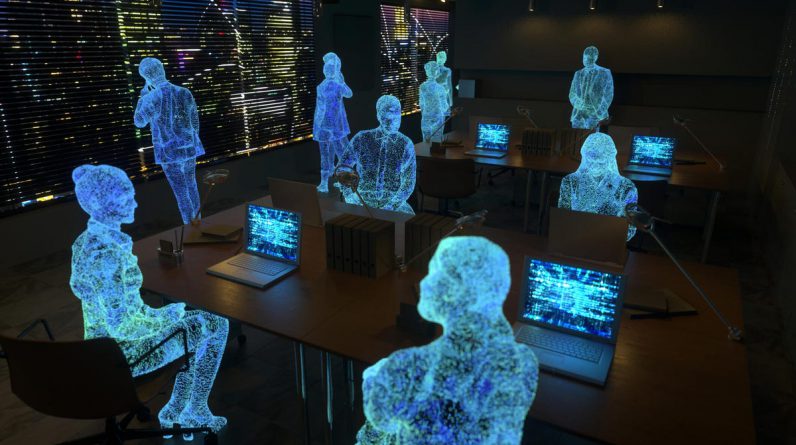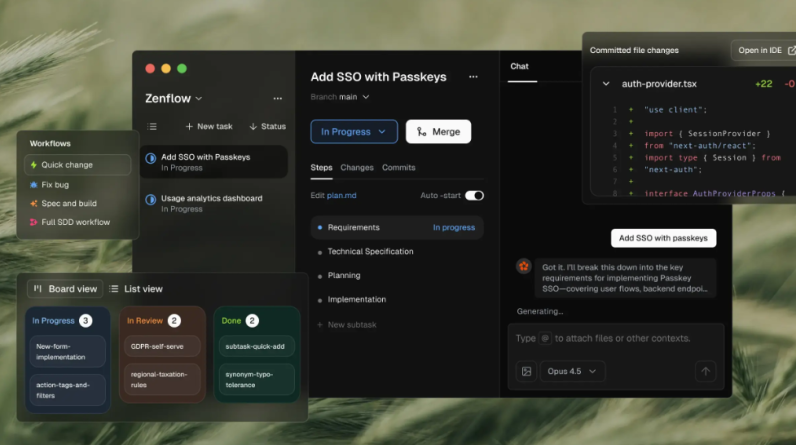
Intel
The AI revolution is upon us, but it remains extremely hard for business leaders to set a direction and vision and to make plans with any certainty. Still, we can offer some relatively uncontroversial observations regarding current and future capabilities — around which we can start to build a broad picture of this revolution. These include:
Also: Welcome to the AI revolution: From horsepower to manpower to machine-power
- AI is already impressive in its generative and predictive capabilities and is only going to keep getting more so.
- There is a huge amount of investment and excitement in the space, which seems unlikely to abate any time soon.
- CEOs are always on the search to achieve more with less (growth and margin).
- Many jobs — or parts of jobs — are routine, procedural, or algorithmic in nature, and are therefore candidates for reallocating to AI resources. According to H. James Wilson and Paul Daugherty in Harvard Business Review (Sept-Oct 2024), most business functions and more than 40% of all US work activity can be augmented by AI.
- New companies very soon will be AI natives, meaning that they simply will not hire humans in the first place except when they have to. These companies will probably show the rest of us where humans are still valuable and where they’re not, and we’ll follow suit (some faster than others).
On this patchy but still relatively solid ground, we were inspired by “The 6 Levels of Driving Automation” — created by the Society of Automotive Engineers — to develop a framework that reflects this evolution of AI capabilities and how they will affect companies over the next decade or so.
A continuously improving set of AI resources over the next decade will have a two-fold impact on business and the human workforce. Initially, AI will have a broadly augmentative effect, taking over low-value tasks and empowering humans to focus their efforts on more strategic and creative jobs.
But at some stage, likely in five years or so, AI will start to take over entire job roles, starting with the most “procedural” or rules-based jobs. Eventually, it will acquire enough decision-making and orchestration capabilities to take over entire teams and even lines of business.
These two distinct effects, which we’ve labeled an Augmentative phase and a Replacement phase, will likely happen gradually at first, then more quickly. However, the speed and depth of adoption will vary by industry, function, team, and individual.
The 6 Levels of Autonomous Work
King and Afshar – Co Authors
The six levels of autonomous work
What follows is a row-by-row discussion of the chart above.
Level: Each autonomous work level is labeled by number (0-6) and title. The title refers to the amount and complexity of work that AI can do at that level. It is essentially a generic work breakdown, starting with the smallest and simplest chunk of work, namely a Task (level 1). The next level up from a Task is the Sub-Process (level 2), referring to a group of tasks that are typically performed in sequential order to complete a discrete part of a business process, such as ensuring that all relevant information has been collected accurately and completely to open a customer case.
At level 3, AI has the capacity to complete a business process such as taking a customer order, managing a customer case from open to close, and qualifying a lead. At level 4, AI can complete several processes from beginning to end, performing most of the work that would be conventionally allocated by role, like sales representative, marketing specialist, or service agent. We’re focusing here on typical commercial operations but the equivalent will be true in manufacturing and all other types of operations.
Also: How your business can best exploit AI: Tell your board these 4 things
At level 5, AI or AIs can perform most of the roles associated with any commercial team –including a “manager” and their direct reports — that together execute one or more complex business processes. At level 6, AI can orchestrate the work of multiple teams, functions, and processes, conventionally organized as a business or line of business. Eventually, this will include all small and medium-size businesses, and — in the longer term — large enterprises (although “large” refers purely to business complexity and revenue size, not employee count).
Phase: The six levels of autonomous work described above do not represent a linear trajectory for AI. AI will not evolve to more senior roles in an organization in a traditional career progression. Instead, there will be two quite distinct phases in its progression. The first is levels 1-3, which we can describe as the Augmentation phase in which digital assistants will enable and empower human employees to do their best work, and will create new opportunities for them too.
The second is levels 4-6, which is the Replacement phase in which digital agents will take on increasingly large and complex responsibilities from humans and, over time, begin to replace them.
AI role: Here we describe the main capabilities of AI and its relationship to a human colleague by level. This is from a non-technical perspective. We’ll follow up with a deeper technological perspective on each level if there’s interest but for now we wanted the relationship to stand out.
Also: AI will change all businesses and most leaders are not ready
Human role: This is the flipside to the AI role, again focusing on the relationship between human and AI and their relative responsibilities and capabilities.
Adoption: This is simply the date at which we expect mainstream adopters (broadly encompassing both early and late majority adopter categories) to start applying AI at each level. Innovators and early adopters will be earlier still and the laggards will likely be later unless and until a crisis changes their trajectory.
We know that adoption rates are going to vary from industry to industry and from department to department. Even at the employee level, it’s highly unlikely that adoption will be a smooth process. Some individuals will readily embrace AI, although they are more likely to embrace the AI that frees them from the monotonous and boring aspects of their job than the AI that promises (or threatens!) to perform the more creative and/or strategic parts.
Others still, especially those who fear that their job will be completely replaced by AI, are likely to push back against the whole thing. Broadly speaking, though, we’re already seeing examples of both predictive and generative AI being applied across most industries and we know that more sophisticated and capable bots and agents are coming soon.
Autonomous work implications for business
We’ve identified three important implications of this AI evolution for business and we hope that leaders will recognize that they’re on the horizon and arriving soon, and start to plan accordingly:
- Planning for augmentation vs replacement: First, as we’ve discussed, the six levels do not represent a linear trajectory for AI. Instead, there will be two quite distinct phases in its progression. The first is levels 1-3, which we can describe as the Augmentation phase. Most commentators are focused on this phase because it is uncontroversial and reassuring. Research shows that AI has the potential to automate most tasks in knowledge-based professions by 2030, dramatically increasing the average worker’s productivity. Humans will be elevated by AI, freed from manual, repetitive, and boring tasks — and empowered to focus on strategic and creative activities. AI also may create new opportunities for humans in this phase.
This may, however, obscure the reality of what’s going to happen next. Once AI reaches level 4, we will enter the Replacement phase. When it becomes able to complete a role autonomously, AI will not follow a conventional career progression. It will not be promoted to a position supervising or managing humans performing that role. It will, sooner or later, replace them, and this replacement, when it happens, will happen rapidly. Current HR and Change leaders need to start planning for this now.
-
SUDA Business Operating Model – Boundless Company
King and Afshar – Co Authors
Accelerating responsiveness: AI will help any company accelerate its operating cycles. In our 2023 book Boundless, we introduced the SUDA model (Sense, Understand, Decide, Act) as the operating model for business in the age of AI. AI will enhance any company’s ability to sense, understand, decide, and act, and those companies that do so will gain an advantage over their competitors. They will be able to make more informed decisions more quickly and in so doing will gain what the military have started to call decision dominance and overmatch. (We’ll discuss this in greater depth in a future article.)
Of critical importance here is that a company’s success will depend on reducing the time between each stage of the SUDA model in order to shrink the delta between Sense and Act as close to zero as possible. Each level of the Autonomous Work model represents an increase in AI’s capacity in one of four SUDA stages as well as a general acceleration across the entire model at different scales of decision-making and action-taking — from the minute-to-minute activities of individual employees to end-to-end business processes to strategic, enterprise-wide initiatives. AI will accelerate and amplify both stage and scale. Companies that are not able to reduce their own Sense to Act delta will be overmatched by those that can. -
Beyond human capabilities: AI will not merely progress to being more productive compared to individual human full-time equivalents (FTEs) or being measured in manpower units (as we discussed in our previous article on AI, horses and humans). At levels 5 and 6, AI will demonstrate the ability to handle situations beyond the abilities of any number of humans. It will then be measured in machine power which will not be simply in terms of GPUs/CPUs or Transactions Per Second (TPS) but probably as some function of complexity, accuracy, and speed.
Leadership call to action
AI is coming — it’s here already — and leaders need to realize that it’s not going away even if the current hype level is unsustainable. Even if leaders are not ready just yet to embrace AI itself, there are several things they can do — good business practices regardless — to prepare.
They can design and then implement a company or enterprise-wide data strategy (ideally extending to their business network). Data is now and will continue to be the name of the game, regardless of AI. They can also focus on streamlining their primary business processes, using the wisdom of eliminating, simplifying, and standardizing them before turning to AI to enable and drive them. (Again: a good thing to do regardless of AI.) And on the HR and Change sides of the house they need to have a plan for both AI phases, which they can do before AI is upon them and it’s too late.
Also: Leadership alert: The dust will never settle and generative AI can help
One final note: Although AI may look like a problem to solve, it will also be a significant part of the answer for navigating through increasingly uncertain and volatile times, as we discuss here. AI can play a crucial role in assisting leaders and their teams in making strategic, data-driven decisions and taking effective action.
These are exciting times and we hope our model can help provide just enough structure amidst all the uncertainty and ambiguity for leaders to take action.
This article was co-authored by Henry King, business innovation and transformation strategy leader and co-author of Boundless: A New Mindset for Unlimited Business Success.






